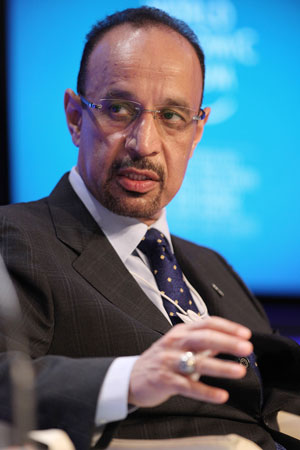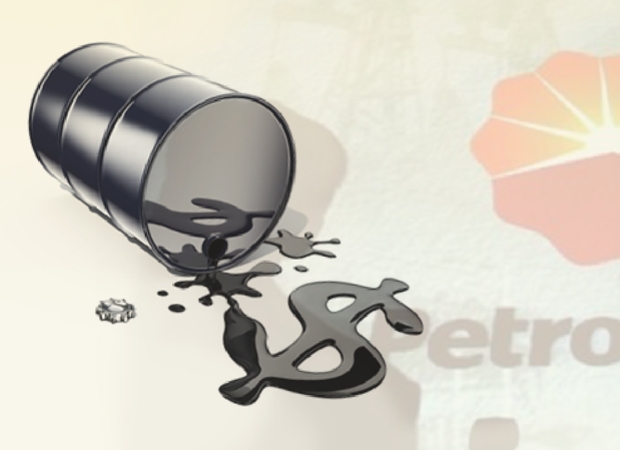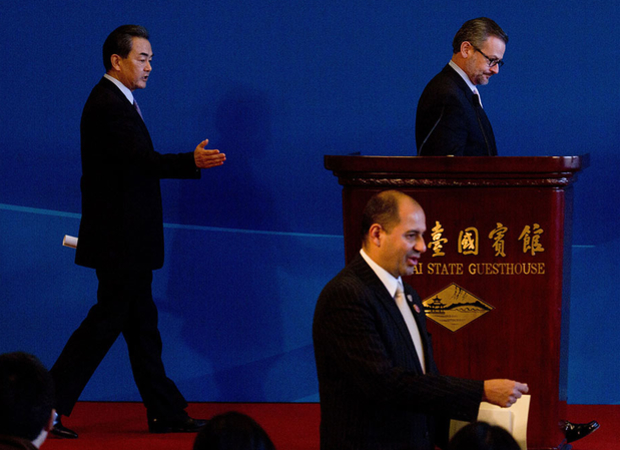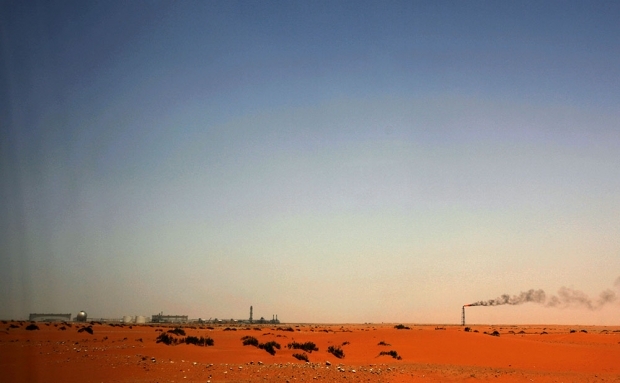Saudi Arabian Oil Company President and CEO Khalid A. Al-Falih has seen global oil prices rise and fall through at least six market cycles during his more than 30 years with the world’s largest crude producer and exporter.
Al-Falih, 55, joined the company as a teenager, long before it was transformed into the state-owned oil giant that today is best known as Saudi Aramco.
Now, against the backdrop of a current market cycle that has seen oil prices fall by half since mid-2014, Al-Falih says Saudi Aramco is adjusting its business focus while seeking fresh opportunities in China. He made the comments recently in Beijing during an exclusive interview with Caixin.

Saudi Aramco is already China’s largest crude supplier, providing about 13 percent of the country’s needs. But Al-Falih sees the company and its owner, the Kingdom of Saudi Arabia, getting even closer to the Middle Kingdom.
Al-Falih said Saudi Aramco wants to work with China on downstream chemical projects and in the consumer products sector. He also sees his company’s oil deliveries to China “potentially doubling at some point in time.”
Saudi Aramco has not been deterred by the ongoing slowdown in China’s economic growth. In fact, Al-Falih said, the company is stepping up research collaboration with Chinese institutions and cooperating more closely with Chinese oil companies. And it is continuing to focus on enterprises in the southeastern province of Fujian that it already operates with China Petroleum & Chemical Corporation and ExxonMobil.
Al-Falih wants Saudi Aramco to become a household name in every Chinese province through new businesses ranging from oil refining to gas stations. To that end, he said, “Saudi Aramco is willing to come in and partner with Chinese companies.” More comments appear below.
Caixin: What is your company’s business plan for China?
Khalid Al-Falih: Saudi Aramco is not new to China. We’ve been in China in various ways since the opening up of the Chinese economy, the rapid growth that started happening in the 1980s, early 1990s. Today we’re an investor, we’re your largest energy provider, [and] we have the number one market share in terms of crude oil supply.
Infographics
06.20.14
The Problem with Chinese Gas Prices
from SohuWe’re also a great partner and collaborator with China, Chinese enterprises, and with the Chinese people. So we’re collaborating beyond energy. We’re collaborating in research, in science, education, and culture, with various aspects of Chinese society. I come to China very often. I visit China probably more than any other country, three or four times a year....
We want to grow with Chinese needs. It will take me a long time to describe it, but we’re not only growing in terms of size. We’re also growing in terms of quality. We’re also trying to address the specific needs of Chinese stakeholders, especially the Chinese people, in terms of providing not only more energy, not only providing higher quality, in terms of environment and better performance and in the efficiency of our energy products, but also working very hard to make them more affordable through our investment, research, and through our collaboration with Chinese enterprises.
We look at every province in China as a province for which we’re responsible, one way or another, to provide affordable and environmentally acceptable energy tools. Right now we’re investing in Fujian, but I’m hoping that in the future every province in China will see the Aramco name through our investments in refining, through our investments in retail distribution, gasoline stations, and through our investments in petrochemicals.
China’s economy is entering a so-called “new normal” period, which means slowing down. How will this impact China’s demand for crude oil from your company?
The new normal is about slowing down as much as it is about raising the quality of growth. So it is about consumers getting higher quality services, higher quality goods, higher living standards, and lifestyles of 1.3 billion Chinese consumers being elevated to first-world standards, not developing-country standards. And I see that not as a threat to Saudi Aramco or a disappointment. I see that as a great opportunity, because we want to provide for China those quality standards that Chinese people are looking for.
What has driven you to invest heavily on research and development?
Saudi Aramco is already the most technology-intensive company in the energy business. We apply and develop technology at a very high level and at huge scale, but we have already announced and committed that we will increase our spending on technology by a factor of five. So five times what we used to spend three years ago will be spent by the end of this decade by building new research centers in Saudi Arabia, where we’re more than doubling our research centers. But I think, significantly, we’re taking our research and technology development global. So we’re opening research centers. In the United States, we’ve opened three. In Europe, we have opened four. In Asia, we already have a research center operating in Beijing. And there will be more opened, as well as one in Korea.
Environment
01.15.15
China-Latin America Summit ‘A Missed Opportunity’ on Low-Carbon Energy
So we’re tapping the great talent, the great research institutions here in China, creating collaborations to find new solutions, to not only make energy efficiency a factor, but also to reduce carbon emissions, to clean the air and allow cities like Beijing and Shanghai and other mega cities in China to be extremely clean, and for the people to enjoy fresh air that every human being deserves. And that requires going back to how energy is used, how it is deployed in engines, whether it’s an automobile or a power plant that makes electricity.
I spent some time at the Chinese Academy of Science. We signed a collaboration agreement with them, and we agreed that we’ll extend our collaboration in all aspects of research into certainly anything that has to do with energy. Two days ago, on the evening I arrived, I went straight from the airport and met with my partner [and] friend, Sinopec Chairman Fu [Chengyu]. We agreed that we will collaborate in science and technology and research. We already have much collaboration. We will be working with our research centers here. But he has also agreed to open research centers in Saudi Arabia for oil services to help Chinese companies take advantage of what we do in Saudi Arabia.
Saudi Aramco built recently, five years ago, the most advanced research university in the world. It’s called King Abudullah University of Science and Technology. It cost billions and billions of dollars. And we did it by collaborating with China. In fact, in the first two years, we had more Chinese students than we had Saudi students.
Do you expect China to further open up its downstream sectors so that your company can come in?
I certainly hope so. Saudi Aramco, as you mentioned, already is China’s largest energy supplier. Our market share in terms of crude oil supply is over 10 percent. In fact, I was just today with the head of the National Energy Administration. He told me that, based on government statistics, Saudi Aramco had 13 percent in 2014 of crude oil demand, which is significant. But we can supply a lot more, because we’re the world’s largest energy supplier. We aspire to supply a lot more. We see our energy supply potentially doubling at some point in time as China’s energy demand grows.
I think what China needs is total commitment, upstream to downstream. We have our own tanker business. We can deliver the energy and then take it through refining, distribution, and retail systems to the neighborhoods of Chinese people, where they live, and provide them with the energy, and the same with chemicals. We want to make environmentally responsible products that Chinese consumers like. That requires a lot of investment, a lot of upgrading.
China today has a system of refineries that are operated by the Chinese national companies, which are great. But to meet the expectations that are coming with the “new normal” of upgrading quality, those refineries either need to be replaced or need massive upgrades with very, very heavy investment. Saudi Aramco is willing to come in to partner with Chinese companies.
What may trigger an oil price rebound?
The likely trigger is not going to be a surprising increase in demand. Demand can increase somewhat, but it is not going to be massive. So the likely trigger is the supply side’s response to the prices, or a supply shock because of geopolitical event, which we hope will not happen. Everybody is hoping for stability in all producing regions. So if there is no shock as a result of geopolitics, the likely reason for prices to rebound will be a gradual reduction in the rate of supply increase as a result of lower capital investment, especially in shale oil investment. It’s very expensive, and the producers there have already cut their capital spending by over 50 percent.
The shale gas industry has come full circle, boom and bust. What’s your view of strategic competition from shale gas?
In the long term, it is healthy because we forecast oil production will continue to increase even in China, where economic growth rates, as you mentioned, have started slowing down. But it’s inevitable that, as more people move into the middle class, they will consume more energy, they will demand more gasoline and more diesel as they buy cars.
In addition, there is a decline in existing production. It is the nature of the oil business that fields decline with time. So you need that extra production, and unconventional business is a good source, not only in the United States but hopefully here in China and in other areas like Saudi Arabia. The problem with unconventional is not the fact that it was there. It is that it came into production very quickly, faster than demand required it to come.
Has Saudi Aramco considered investing in shale gas?
We’re investing in shale gas. In fact, Saudi Arabia probably will be the second frontier for unconventional after the U.S. We have three areas in Saudi Arabia that we have identified as high potential for shale gas. One of them is in the northern part of the kingdom, close to the Jordanian border. That will come into production in 2016, 2017. So, very soon. We’ve already drilled close to 100 wells. We know that it is feasible technologically, and we will make it commercial feasible by continuing to invest.
Have you considered investing in China’s shale gas sector?
So far our strategy at Saudi Aramco…, because we have such huge resources within the kingdom, is that we have concentrated our upstream operations in the Kingdom of Saudi Arabia. We still have a lot to do in Saudi Arabia that is keeping us busy. But in the future, you never know.
What kind of renewable energy are you most interested in?
For us in Saudi Arabia, solar holds great promise because we have a lot of sunshine, like in some parts of China.... In Saudi Arabia the demand is during the day when it gets really hot, when you need air conditioners. That’s when the solar energy is available, so we can make the solar directly correlate with the demand that we need. In other words, when solar energy is available, we use it.
Also, the cost of solar is coming down, thanks a lot to Chinese productivity and Chinese innovation. For Chinese [solar] panels, the cost has been coming down, which is appreciated by the rest of the world. It brings renewable costs down. We also have a lot of silicon in Saudi Arabia, so we can manufacture polysilicon.
How is your company adapting to low oil prices, and how do you mitigate the impact?
The last few years, like everybody else, we’ve been at capacity in oil, building capacity in gas, building capacity in refining, building capacity in chemicals. So we’ve being growing really at a very fast pace. Now, with lower oil prices, we can look at our cost structure and try to be more efficient. We have reduced our operating expenditures, looked at our capital projects that can be delayed, [and] we have delayed them.
The U.S. is going to export shale gas to China sooner or later, and Russia is going to export more oil to China. How do you foresee the competitive landscape?
Our market has always been competitive, and it has always been changing. We used to supply most of our production many, many decades ago to the West, Europe and the U.S. Today we supply 70 percent of our exports to Asia, with China being one of the largest markets. So we are used to competition.
We’re the lowest-cost producer, the highest-technology producer. We’re also partners with our customers for the long-term. We’re not switching day-to-day based on who will pay us the highest price.
What kind of transition are you going through?
Saudi Aramco has been the world’s largest upstream company for two decades, especially in oil. And our gas has been growing significantly, mostly for domestic consumption, with liquids, gas liquids being exported. We've been a relatively small player in the downstream. So our transformation, which you referred to, is about making Aramco integrated in oil, gas, refining, [and] chemicals.
We’ll be the world’s largest refiner [and] we’ll be the world’s largest chemicals company. We will also move from primarily being B2B, just selling feedstock to refiners, chemical plants at the wholesale level. We’ll be more consumer-facing, so consumers in the future will see Aramco in cities providing energy. I think, significantly, we’re also becoming an innovative company.
We’ve already talked about technology. Saudi Aramco is going to become the most innovative technology company on the planet, certainly in the energy space.
What is your view of Saudi Aramco’s future cooperation with Chinese companies?
China is coming out under President Xi Jinping’s leadership. China is switching from looking inward to looking outward, and becoming a global leader. We welcome this. China’s already the world’s second-largest economy, the largest economy in our eastern hemisphere. [Xi’s] “one belt, one road” initiative is visionary. It encompasses two ends of Asia, eastern Asia led by China, and western Asia and the Middle East led by Saudi Arabia, and everywhere in between.
Saudi Arabia and China can be partners and bring this vision to reality. Saudi Arabia has already committed to investing in the new bank that China will be leading, the AIIB (Asian Infrastructure Investment Bank). Saudi Arabia was one of the first countries to sign up. We want to be a platform for China to serve and access the markets in the Middle East and Africa. We will be making infrastructure available in Saudi Arabia to Chinese companies to invest, to serve our market, the regional market, and even the African continent. So I hope that Chinese leaders will see the opportunities that Saudi Arabia can present.




